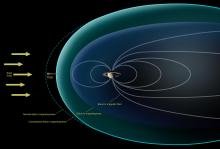Listen to today's episode of StarDate on the web the same day it airs in high-quality streaming audio without any extra ads or announcements. Choose a $8 one-month pass, or listen every day for a year for just $30.
You are here
Moon and Saturn
The night will get a lot brighter after about 2 or 3 o’clock tomorrow morning, as the gibbous Moon climbs into good view. But it won’t be nearly as bright as the nightside of a planet that appears quite close to the Moon: Saturn, the second-largest planet in the solar system. It’s just below the Moon as they rise, and looks like a bright star.
The Moon brightens the night sky by reflecting sunlight in our direction. Saturn’s night is brightened by reflected sunlight as well — from its brilliant rings.
The rings extend tens of thousands of miles from Saturn. That gives them a surface area of hundreds of millions of square miles. And the rings are made mainly of small bits of ice, which reflect a lot of sunlight. That combination makes them quite bright. In fact, as seen from here on Earth, the rings can be as bright as Saturn itself.
Around the solstices on Saturn, the rings are tilted in such a way that they reflect a lot of sunlight onto Saturn’s nightside. So nighttime can be brighter than a night under a full Moon here on Earth. And there was a solstice recently, so that’s what Saturn is experiencing right now.
Around the planet’s equinoxes, though, the rings are tilted almost edge-on to the Sun. They don’t catch much sunlight, so they can’t reflect it back onto the planet — leaving Saturn with dark night skies.
Another planet is also close to the Moon: Mars, which is just below Saturn as they rise. More about that tomorrow.
Script by Damond Benningfield





